CA Saket Ghiria
2015 is over. First we wish all the readers a very prosperous & successful 2016. Now as we know that 2015 is over, how this year really was for India is a question we should be a bit concerned about. The new government took office in May 2014 with the motive of making a visible economic progress in the country. So till now it is nearly 18 months over for the new government. Year 2015 was fully under the regime of the new government. It is true that a visible change into the conditions needs significant time devotion, but are things going as intended by the new government. This is what we would try to find through this article. There would be two parts of the article. While the second part will be there within a few days, we hope that you would find the first part interesting & useful. We would try to do an economic analysis of the year 2015 on the following parameters:
- GDP of the Country
- FDI in the Country
- Forex Reserves of India
- Inflation
- Exports
- Crude Oil prices
- Performance of Indian Currency INR
- Performance of Indian Markets
- Collection of Taxes in the country
- Ease of doing business in India
Gross Domestic Product (GDP) of the Country
The easiest way to understand Gross Domestic Product is to consider it like a salary slip of any individual. The bigger the salary slip the better it is. GDP represents the prosperity of any country. In other words how much the country produces in a final value terms of all goods and services in a year is represented by GDP data. The higher the GDP of the country, the better it is as its citizens are richer and more prosper. We often hear that it is not the size of GDP but the happiness which is needed to live a perfect life. But the harsh truth is that at the end of the day, it is money which matters the most and every other thing becomes secondary. India has a nominal GDP of around $2 Trillion which translates into the per capita income of approx. $1600. Following is how the GDP growth stood in India in the recent past. From the image we can see that in 2014 end, the annualized GDP growth rate stood at 7.2% and at the end of the year 2015, the annualized GDP growth rate stood at 7.5%. So we can see that the year 2015 was better than the year 2014 as far as GDP growth is concerned. The GDP growth rate at 7.5% made India the fastest growing major economy of the world putting China in the 2nd place.
Foreign Direct Investment (FDI) in the country
As we all know that India is a consumer nation with over 1.2 Billion people to feed and having very marginal industrial base, growth in India becomes highly endangered. Adding ice to the cake, India is a least innovative country with a very limited or no scope of technology development. More than 60% of our working population is dependent upon agriculture and other related activities. Considering all these unique things, indigenous growth options became very limited in India. Indigenous growth means having growth within i.e. through own resources. Foreign direct investment or FDI is a tool which is used by the countries to get rich quick. In other words, through FDI a country attracts capital, technology, human resource and knowhow to its soil thereby it escapes itself from the lengthy and painful and costly process of technology development of its own. For all emerging countries, FDI acted as ‘Sanjivani Booti’ as by attracting FDI, all these nations pulled themselves out from the centuries of poverty and became the part of global economic system. We have the examples of Japan, China, Malaysia, Indonesia, Thailand, Korea, Taiwan etc. Bangladesh is a special country which has very large population, very small landmass and a very bloody struggle of independence from Pakistan. In the struggle of independence there was around 3 Million people been killed and in 1971, Bangladesh eventually became an independent nation separate from Pakistan. Bangladesh attracted huge FDI in the sectors like readymade garments, small equipment’s etc. which helped Bangladesh to lift millions of its people out of poverty. Today Bangladesh is one of the largest exporter of readymade garments. Though FDI has certain inherent limitations and drawbacks, but when we compare the merits and demerits, the merits definitely outweigh the demerits. As we discussed that India has some unique features of its own, it became very crucial for India to attract on continuous basis the foreign direct investments so to keep growing the economy and raising the standard of living of the masses. Under the new regime, as the economic development agenda was on top, Modi Government has taken several steps in increasing the foreign direct investment in India and working on a highly appreciated program of ‘Make in India’, Mr. Modi visited around the globe to attract FDI from the global corporates. India is now opening up the sectors for the foreigners which used to be considered very sensitive until the recent past and previous governments avoided those sectors for foreigners. The recent big bang reform on FDI was done in the month of November when the cabinet eased FDI norms across 15 sectors including defence, banking, construction, single brand retail, broadcasting and civil aviation. Government also approached the wealthy NRIs of the country who are capable of Investing in India by threating the investment made by companies/trusts/partnerships owned & controlled by NRIs on non-repatriation basis as domestic investment. Government also approved 100% FDI in limited liability partnerships (LLPs) under the automatic route. To promote the plantation activities in the Country and making India self-sufficient in this area, government also decided to plantation activities namely; coffee, rubber, cardamom, palm oil tree and olive oil tree plantations also for 100% foreign investment under automatic route. As of now, only tea plantation was open to foreign investment. This was a good move as increased high value plantation will help India to reduce export of these things. So we can see that Govt. has taken lot of steps for bringing the FDI in the country and this is reflected through the above picture. According to some estimates, India receive around $35 Billion as foreign direct investment in 2015-16 compared to the $22 Billion in the year 2014-15. So this is a very massive increase in the year 2015.
Forex Reserves of India
As we all know that the global trade is dominated primarily on American Dollars (USD), a country needs sufficient Dollars to pay off its import bills and other international obligations. For a country like India which has very little influence on global monetary system, global trade system, global politics and other international matters, India needs sufficient USD ($) to pay off its international obligations. If we look at the forex holdings of other major countries then we can find that China is the single largest holder of foreign currencies with over $4 Trillion of forex reserves, followed by Japan, Saudi Arabia etc. Coming back to the Indian scenario, India seen huge crises of forex reserves in 1980’s and this eventually forced India to go for economic liberalization process. After entering into the era of economic liberalization, India gradually accumulated its forex reserves. Through the image we can see that the forex reserve of India stood at $320 Billion at the end of 2014, which grown up to $351 Billion at the end of 2015. So in 2015, India added up roughly $30 Billion in its forex reserves. So 2015 was a good year as far as forex building is concerned.
Inflation
Inflation is probably the biggest nightmare for the masses in India as due to the uncontrolled inflation country has seen in the last decade has forced many low to medium earning people to change their lifestyle in a more conservative way. India has never been a country of a stable low inflation as we know that India is a nation with over 1.2 Billion people to feed and we have a massive underemployment in the agriculture sector due to which productivity is very little and wastage is huge. All these things plus export of food grains to control the balance of payment situation caused constantly high inflation particularly consumer price inflation in the country. Now the only way to cool inflation is raising yield per acer, better storage & transportation mechanism, better crop planning and management etc. From the image we can see that at the beginning of 2015, consumer price index was at 5.25% which has fallen to below 4% in the mid of the year but it started rising again and stood at 5.5% at the year end. The year of 2015 was definitely a better year as far as inflation is concerned as the inflation was ranging at 7-9% in the previous years.
Exports
As we discussed earlier that the global monetary, payment and trade system is dominated in American Dollars and yes you can also count Euro, Japanese Yen and British Pound for a broader coverage. Now the question arises that a nation like India which has no reserve currency status as well as India is not authorized to print American Dollars of its own, how can India get Dollars to meet its import obligations. Now there are few ways of getting the Dollars like Foreign Direct Investment including other foreign investments, foreign aid, foreign tourists & students etc. visiting India, remittances by the workers staying abroad. But the most prominent, stable and respectable way of earning the foreign currency is through exports. This is why almost all nations done everything to increase their exports and uses a lot of tools for the same like free trade agreements, subsidies, most favoured nations, special status nation etc. A falling exports is the most serious challenge for a country which hampers the country in many ways. China became a super power by first acquiring the title of ‘Factory of the World’. So this is the significance of exports. This is very important to have a strong export base in the country as only through export a nation makes its companies as ‘Global Brands’. As we can see from the image that the export of the country is continuously falling both in the year 2014 and the year 2015. Despite the hard effort from the side of government the export of the country is falling and the following could be the major reasons for this:
- Low & inferior quality products from the Indian manufacturers compared to foreign counterparts.
- Uncompetitive products based on cost & price factor.
- Sharp decline in the prices of petroleum and energy related products thus causing recession in the petroleum exporting countries like Saudi Arab, Russia and other Middle Eastern Countries and hence reduced demand.
- Continuous decline in the prices of commodities thus causing recession in the commodity exporting countries like Brazil, Australia, South Africa, Russia etc. and hence reduced demand.
- Slowdown in Chinese economy and as China is the second largest economy, any slowdown in China triggers a recessionary pressure on the entire global economy.
- Advanced economies like United States, Europe etc. are still to recover fully from the recession of 2007-08 and thereafter aftershocks.
In the fiscal year 2014-15, total exports stood at around $320 Billion while for the fiscal year 2015-16, the expected exports figure are just $265 Billion. This is a massive decline. So anything could be blamed for the falling exports but main thing is that falling exports is a real danger as it reduces the confidence of both domestic as well as foreign investors into the economy, makes currency volatile and increases the prices of imported goods.
So we covered some of the economic indicators and how they performed in the year 2015. Being the part one of the complete article, we will limit us till here. In the next part we will cover the remaining indicators.
Disclaimer: We would like to state that this article is our original work. We have sourced data from the websites like Wikipedia and Times of India. We would also like to acknowledge the efforts of CA. Atul Agarwal and Mr. Sumit Ghiria for the compilation of data and creation of tables, editing of images and typing of text. You can always write your comments and feedbacks at casaketghiria@gmail.com.



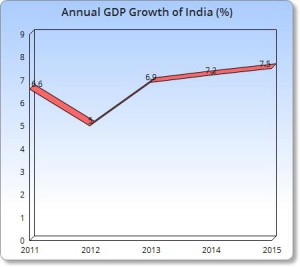
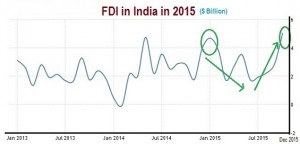
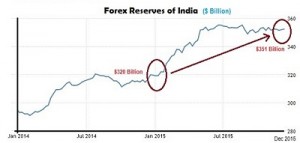
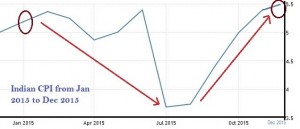
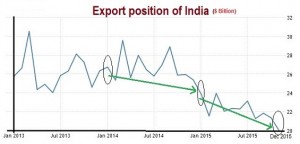



Good article
Nice Article
Thank you sir, this is what we expected from our central govt
Starting my activity in the morning -with a tooth brush everything is mmfd.by a foreign country. Research labs are increasing but no item of india -purelee is found in my home. ? Should I be affected the above….not bothered to read.
Despite the known fact that 70% of our population are rural based and dependent on agriculture, this segment has not enjoyed the priority it deserves, apart from the awful lack of agriculture produce rotting in open as frequently reported in the media reports. Why should the Govt. export food articles to control the balance of payments when there is shortage of these articles in the country and the prices of some of the essential commodities are becoming unaffordable for the common man? RBI has been consistently advising the Govt. to improve the supply side of these commodities to control inflation but the Govt. is apparently concerned mostly over shoring up consumption of industrial goods and expecting RBI to bring down the CRR etc.
In short, governance is lopsided and needs re-look at our priorities as far as inflation is concerned.
K R SRINIVASAN